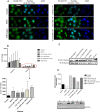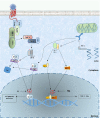Lithium inhibits NF-κB nuclear translocation and modulate inflammation profiles in Rift valley fever virus-infected Raw 264.7 macrophages
- PMID: 34088327
- PMCID: PMC8177254
- DOI: 10.1186/s12985-021-01579-z
Lithium inhibits NF-κB nuclear translocation and modulate inflammation profiles in Rift valley fever virus-infected Raw 264.7 macrophages
Abstract
Introduction: Rift Valley fever virus (RVFV) is a zoonotic life-threatening viral infection endemic across sub-Saharan African countries and the Arabian Peninsula; however, there is a growing panic of its spread to non-endemic regions. This viral infection triggers a wide spectrum of symptoms that span from fibril illnesses to more severe symptoms such as haemorrhagic fever and encephalitis. These severe symptoms have been associated with dysregulated immune response propagated by the virulence factor, non-structural protein (NSs). Thus, this study investigates the effects of lithium on NF-κB translocation and RFVF-induced inflammation in Raw 264.7 macrophages.
Methods: The supernatant from RVFV-infected Raw 264.7 cells, treated with lithium, was examined using an ELISA assay kit to measure levels of cytokines and chemokines. The H2DCF-DA and DAF-2 DA florigenic assays were used to determine the levels of ROS and RNS by measuring the cellular fluorescence intensity post RVFV-infection and lithium treatment. Western blot and immunocytochemistry assays were used to measure expression levels of the inflammatory proteins and cellular location of the NF-κB, respectively.
Results: Lithium was shown to stimulate interferon-gamma (IFN-γ) production as early as 3 h pi. Production of the secondary pro-inflammatory cytokine and chemokine, interleukin-6 (IL-6) and regulated on activation, normal T cell expressed and secreted (RANTES), were elevated as early as 12 h pi. Treatment with lithium stimulated increase of production of tumor necrosis factor-alpha (TNF-α) and Interleukin-10 (IL-10) in RVFV-infected and uninfected macrophages as early as 3 h pi. The RVFV-infected cells treated with lithium displayed lower ROS and RNS production as opposed to lithium-free RVFV-infected control cells. Western blot analyses demonstrated that lithium inhibited iNOS expression while stimulating expression of heme oxygenase (HO) and IκB in RVFV-infected Raw 264.7 macrophages. Results from immunocytochemistry and Western blot assays revealed that lithium inhibits NF-κB nuclear translocation in RVFV-infected cells compared to lithium-free RVFV-infected cells and 5 mg/mL LPS controls.
Conclusion: This study demonstrates that lithium inhibits NF-kB nuclear translocation and modulate inflammation profiles in RVFV-infected Raw 264.7 macrophage cells.
Keywords: Inflammation; Macrophages; RVFV and NF-kB.
Conflict of interest statement
There are no financial and non-financial competing interests.
Figures





Similar articles
-
The NSs Protein Encoded by the Virulent Strain of Rift Valley Fever Virus Targets the Expression of Abl2 and the Actin Cytoskeleton of the Host, Affecting Cell Mobility, Cell Shape, and Cell-Cell Adhesion.J Virol. 2020 Dec 9;95(1):e01768-20. doi: 10.1128/JVI.01768-20. Print 2020 Dec 9. J Virol. 2020. PMID: 33087469 Free PMC article.
-
Rift Valley fever virus inhibits a pro-inflammatory response in experimentally infected human monocyte derived macrophages and a pro-inflammatory cytokine response may be associated with patient survival during natural infection.Virology. 2012 Jan 5;422(1):6-12. doi: 10.1016/j.virol.2011.09.023. Epub 2011 Oct 22. Virology. 2012. PMID: 22018491 Free PMC article.
-
Rift Valley Fever Virus Propagates in Human Villous Trophoblast Cell Lines and Induces Cytokine mRNA Responses Known to Provoke Miscarriage.Viruses. 2021 Nov 12;13(11):2265. doi: 10.3390/v13112265. Viruses. 2021. PMID: 34835071 Free PMC article.
-
Single-cycle replicable Rift Valley fever virus mutants as safe vaccine candidates.Virus Res. 2016 May 2;216:55-65. doi: 10.1016/j.virusres.2015.05.012. Epub 2015 May 27. Virus Res. 2016. PMID: 26022573 Free PMC article. Review.
-
Insights into the Pathogenesis of Viral Haemorrhagic Fever Based on Virus Tropism and Tissue Lesions of Natural Rift Valley Fever.Viruses. 2021 Apr 20;13(4):709. doi: 10.3390/v13040709. Viruses. 2021. PMID: 33923863 Free PMC article. Review.
Cited by
-
Understanding immune-modulatory efficacy in vitro.Chem Biol Interact. 2022 Jan 25;352:109776. doi: 10.1016/j.cbi.2021.109776. Epub 2021 Dec 11. Chem Biol Interact. 2022. PMID: 34906553 Free PMC article. Review.
-
Lithium, Inflammation and Neuroinflammation with Emphasis on Bipolar Disorder-A Narrative Review.Int J Mol Sci. 2024 Dec 11;25(24):13277. doi: 10.3390/ijms252413277. Int J Mol Sci. 2024. PMID: 39769042 Free PMC article. Review.
-
Transcriptome Analysis Reveals Anti-inflammatory, Antiapoptotic, and Milk Synthesis-Promoting Effects of Lithium Chloride in Bovine Mammary Epithelial Cells.Biol Trace Elem Res. 2025 Apr 11. doi: 10.1007/s12011-025-04614-0. Online ahead of print. Biol Trace Elem Res. 2025. PMID: 40214951
-
Enhancing the immune effect of oHSV-1 therapy through TLR3 signaling in uveal melanoma.J Cancer Res Clin Oncol. 2023 Feb;149(2):901-912. doi: 10.1007/s00432-022-04272-y. Epub 2022 Aug 28. J Cancer Res Clin Oncol. 2023. PMID: 36030435 Free PMC article.
-
Efficacy and Safety of Lithium Treatment in SARS-CoV-2 Infected Patients.Front Pharmacol. 2022 Apr 14;13:850583. doi: 10.3389/fphar.2022.850583. eCollection 2022. Front Pharmacol. 2022. PMID: 35496309 Free PMC article.
References
-
- Ghaemi-Bafghi M, Haghparast A. Viral evasion and subversion mechanisms of the host immune system. ZJRMS. 2013;15(10):6–1.
Publication types
MeSH terms
Substances
LinkOut - more resources
Full Text Sources
Research Materials
Miscellaneous

